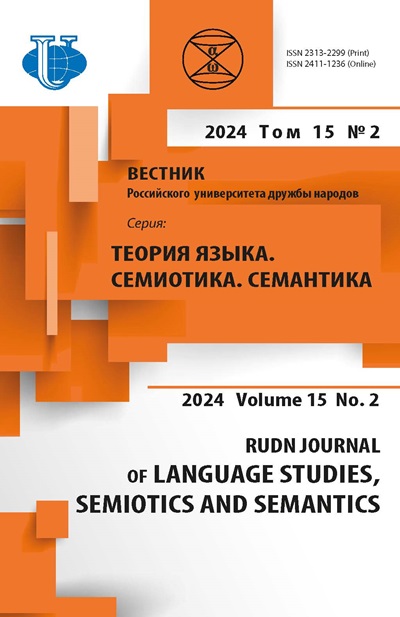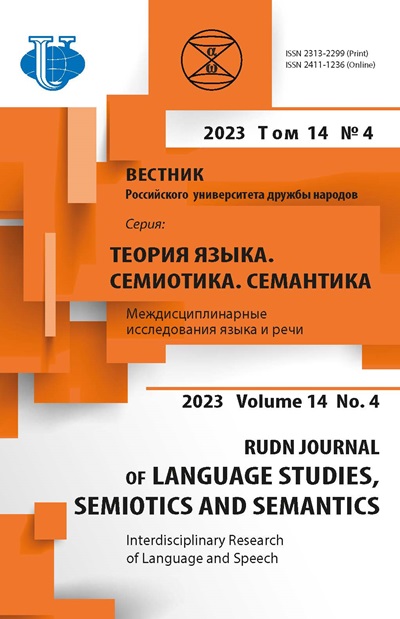Semantic Structure of the Word in the Perspective of Interdisciplinary Research
- Authors: Klimenko G.V.1
-
Affiliations:
- Moscow State Linguistic University
- Issue: Vol 14, No 4 (2023): INTERDISCIPLINARY RESEARCH OF LANGUAGE AND SPEECH
- Pages: 1201-1216
- Section: SEMIOTICS. SEMANTICS. PAREMIOLOGY
- URL: https://journals.rudn.ru/semiotics-semantics/article/view/37660
- DOI: https://doi.org/10.22363/2313-2299-2023-14-4-1201-1216
- EDN: https://elibrary.ru/BIGUGK
Cite item
Full Text
Abstract
The study is devoted to actual issues of cognitive linguistic and cultural linguistic. Both sciences are sciences of the synthesizing type, and they make it possible to explore a linguistic sign in its deep functions related to the mentality and culture of a particular linguistic community. The object of the research is the commonly used Russian lexeme a head , which is the key sign of the corresponding concept. Its semantic structure, paradigmatic and national-cultural characteristics are established. The novelty of the study lies in the complex of applied methods: vocabulary definition analysis, contextual analysis, introspection method, cognitive interpretation of the results obtained. A culturological commentary is provided. Theoretical value of the study: the synthesizing approach allows us identify the structure and content of the concept, as well as cultural attitudes transmitted by language signs. Applied value: the results of the study can be used in lexicographic practice, as well as in the courses on cognitive linguistics, cultural linguistic, theory of intercultural communication.
About the authors
Galina V. Klimenko
Moscow State Linguistic University
Author for correspondence.
Email: gal.klim2009@yandex.ru
ORCID iD: 0000-0002-6552-4396
SPIN-code: 9874-7099
PhD (Philology), Associate Professor, the Honored Professor of the Department of Russian as a Foreign Language
38, Ostozhenka str., Moscow, Russian Federation, 119034References
- Zvegintsev, V.A. (1957). Semasiology. Moscow: Moscow University Publ. (In Russ.).
- Vinogradov, V.V. (1977). Selected works. Vol. 3. Lexicology and lexicography. Moscow: Nauka. (In Russ.).
- Apresyan, Yu.D. (1995). Selected works.Vol. 1. Lexical semantics. Moscow: Languages of Russian culture. (In Russ.).
- Sternin, I.A. (1985). Lexical meaning of a word in speech. Voronezh: Voronezh University Publ. (In Russ.).
- Nikitin, M.V. (1983). Lexical meaning of the word (structure and combinatorics). Moscow: Vysshaya shkola. (In Russ.).
- Ufimtseva, A.A. & Stepanov, Yu.S. (1986). Lexical meaning. The principle of semiological description of vocabulary. Moscow: Nauka. (In Russ.).
- Shmelev, D.N. (1973). Problems of semantic analysis of vocabulary. Moscow: Nauka. (In Russ.).
- Kobozeva, I.M. (2008). Linguistic semantics. Moscow: LIBROCOM. (In Russ.).
- Boyarskaya, E.L. (2019). Development of the methodology of cognitive analysis of a polysemantic word. In: Methods of cognitive analysis of word semantics. Computercorpus approach. Moscow: YASK. рр. 81–119. (In Russ.).
- Boldyrev, N.N. (2014). Cognitive semantics. Introduction to Cognitive Linguistics:a course of lectures. Tambov: TSU n.a. G.R. Derzhavin publ. (In Russ.).
- Linguistic encyclopedic dictionary (1990). V.N. Yartseva (Ed.). Moscow: Soviet Encyclopedia. (In Russ.).
- Pesina, S.A. (2011). Word in cognitive aspect: V monograph. Moscow: FLINT: Nauka. (In Russ.).
- Lakoff, J. (2011). Women, fire and dangerous things: what categories of language say about thinking. B. 1: The Mind outside the Machine. (In Russ.).
- Klimenko, G.V. (2020). Concepts “head”, “face”, “hand” in Russian and English. Monograph. Moscow: Prometheus. (In Russ.).
- Gudkov, D.B. & Kovshova, M.L. (2007). Russian culture’s body code. Moscow: Gnosis. (In Russ.).
- Safaralieva, L.A. (2021). Evolution of the associative-verbal network of the concept of “Old Age” in the linguistic consciousness of native Russian speakers of the 20s of the XXI century. RUDN Journal of Language Studies, Semiotics and Semantics, 12(4), 1147–1159. https:// www.doi.org/10.22363/2313-2299-2021-12-4-1147-1159 (In Russ.).
- Vorkachev, S.G. (2005). Postulates of linguoconceptology. In: Anthology of concepts. Vol. 1. Volgograd: Paradigm. pp.11–13. (In Russ.).













